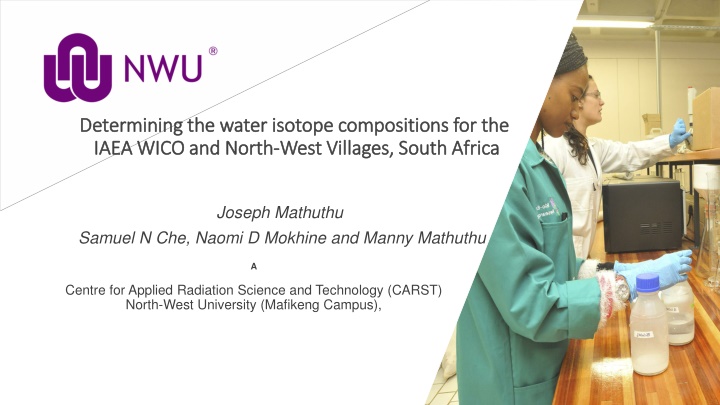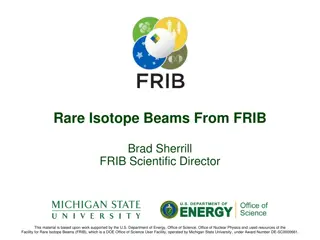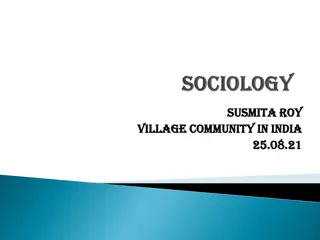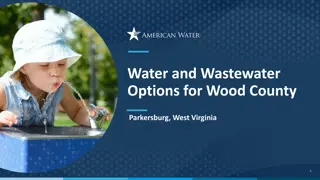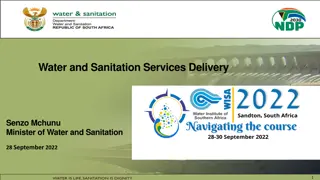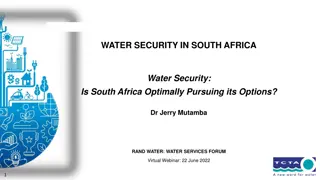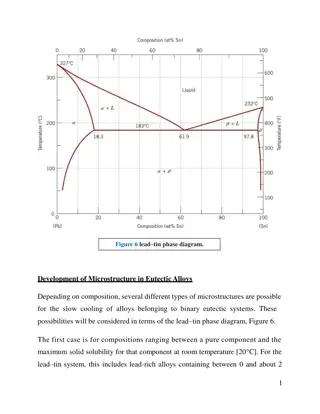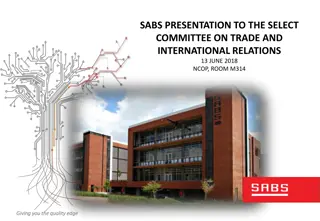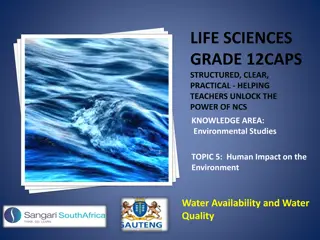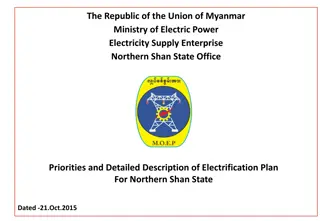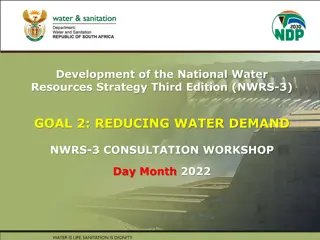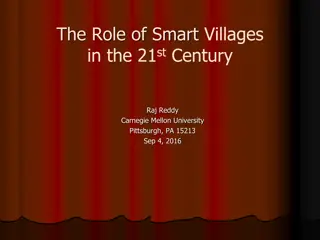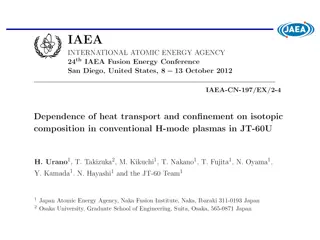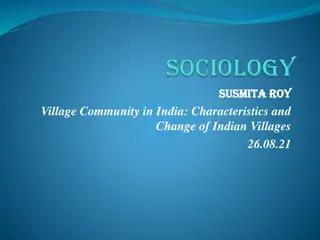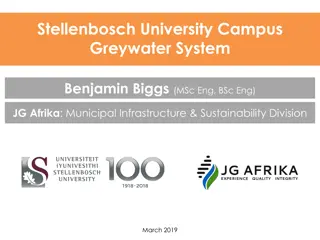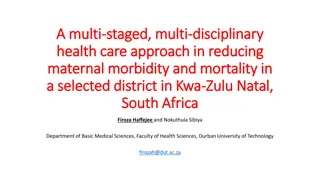Water Isotope Compositions in North-West Villages, South Africa
Water stable isotopes (18O and 2H) play a crucial role in understanding meteorological processes. This study aims to determine water isotope compositions in IAEA WICO and North-West villages of South Africa. Specific objectives include evaluating the Global and Local Meteoric Water Lines, analyzing deuterium-excess values, and more. Samples were collected and analyzed to achieve these goals.
Download Presentation

Please find below an Image/Link to download the presentation.
The content on the website is provided AS IS for your information and personal use only. It may not be sold, licensed, or shared on other websites without obtaining consent from the author.If you encounter any issues during the download, it is possible that the publisher has removed the file from their server.
You are allowed to download the files provided on this website for personal or commercial use, subject to the condition that they are used lawfully. All files are the property of their respective owners.
The content on the website is provided AS IS for your information and personal use only. It may not be sold, licensed, or shared on other websites without obtaining consent from the author.
E N D
Presentation Transcript
Determining the water isotope compositions for the Determining the water isotope compositions for the IAEA WICO and North IAEA WICO and North- -West Villages, South Africa West Villages, South Africa Joseph Mathuthu Samuel N Che, Naomi D Mokhine and Manny Mathuthu A Centre for Applied Radiation Science and Technology (CARST) North-West University (Mafikeng Campus),
Introduction Water stable isotopes (SI) (18O and 2H) have been widely used to study a variety of meteorological and catchment-scale processes (McGuire and McDonnell, 2007). The stable isotopes 18O (oxygen-18) and 2H (deuterium) are fingerprints of water flow, such as rainfall, infiltration, subsurface movement and stream discharge (Kendall and Caldwell, 1998 ). Identifiable isotopic character is provided by the kinetic fractionation of 2H and l8O which occurs during condensation unlike during evaporation (Rao and Kulkarni, 1997) .
Introduction cont.. Physical conditions like humidity, air temperature and sea surface temperature directly affects the deuterium excess value. The deuterium excess reflects the slower diffusion of the 2H and 18O molecule (Pfahl and Sodemann, 2014) . Understanding changes in local precipitation requires use of the Local Meteoric Water Line (LMWL).
Research Aim The aim of this study was to determine the water isotope composition for the IAEA WICO 2020 samples and samples in North-West (NW) Villages in South Africa.
Specific objectives The main objectives were to: Evaluate the Global Meteoric Water Line (GMWL) for the IAEA. Determine the Local Meteoric Water Line (LMWL) for the North-West Province in South Africa. Analyze the deuterium-excess and gradient from the GMWL
Figure 1: Figure 1: Study area of selected villages in the North-west Province
Methods of investigation Samples and data collection Six water samples (OH-25 OH-30) were received by North-West University (NWU) Centre for Applied Radiation Science and Technology (CARST) laboratory from IAEA WICO project Ref# 20318A to perform Water Isotope Inter-laboratory comparison tests. Forty (40) borehole water samples [SM1-10], [SL1, SL3, SL4, SL5, SL7, SL9, SL10, SL11, SL12, SL13], [SK1, SK5, SK6, SK11, SK12, SK13, SK14, SK15, SK16, SK18, SK19, SK20] and [C, D, E, S2K, S3K, S7K, S10K, S17K] respectively were collected from Mafikeng, Lichtenburg, Klerksdorp and Setlagole villages in North West province, South Africa in the months of March to April 2021
Samples preparation In the laboratory, the water samples were filtered using a qualitative filter paper, 413 of size 90mm and then refrigerated at a temperature of 4oC. No acid was added to the water samples to avoid contamination of the water isotopes. Standard laboratory protocols were observed during the sample preparation and analysis.
Sample preparation cont Samples analysis The water samples were calibrated and analysed using the Cavity Ring down Spectrometer with laser- current-tuned cavity resonance (Picarro L2130-i Isotope H2O). To calibrate and monitor the equipment, three internal laboratory standards; Picarro Zero ( 18O= 0.3 , 0.2 ; D= 1.8 , 0.9 ), Picarro Mid ( 18O= -20.6 , 0.2 ; D= -159.0 , 1.3 ) and Picarro Depl ( 18O= -29.6 , 0.2 ; D= 235.0 , 1.8 ) developed at Picarro's stable isotope laboratory were evaluated after every 20 water samples. The Picarro standards were calibrated against the Vienna Standard Mean Ocean Water (VSMOW) standard. Nine (9) injections per sample vail were analyzed using SGE 10 l syringe, the average of the best 4 replicates was recorded by the Isotopic Water Analyzer Software
Results and discussion IAEA WICO RESULTS Table 1: Evaluation of d-excess for IAEA WICO compared to the IAEA reference standard
Results Discussion For Table 1 the submitted 2H values are in agreement with the reference 2H values. Evaluation of the z-test and the zeta test results showed that they were satisfactory showing our lab is capable of characterisation of IAEA inter-laboratory comparisons. The results obtained from d-excess were in the satisfactory range and the margins of error were close to those required by the IAEA.
Figure 2: the s-plots for 18O for IAEA WICO samples OH28-OH-30
Results discussion The s-plots for 18O results in Figure 2 are used to determine the precision of a laboratory for inter-comparisons. Our results obtained with the Picarro are in the satisfactory (green) range, thus they are consistent with the IAEA WICO standard.
North-west Province Results Figure 3: Plot of ?2H vs ?18O for Setlagole, Mafikeng, Lichtenburg and Klerksdorp (A, B, C, and D), respectively.
Discussion of the North West Province results Plot of ?2H vs ?18O for Setlagole, Mafikeng, Lichtenburg and Klerksdorp (A, B, C, and D), respectively. The slope of the Local Meteoric Water Line (LMWL) of Setlagole and Lichtenburg is lower than that of the Mafikeng and Klerksdorp (6.6806 vs 5.47 vs 7.5316 vs 7.0579) respectively. The slope of the Local Meteoric Water Line (LMWL) of NW villages is lower than that of Global Meteoric Water Line (GMWL) at 6.4401 vs 8. It might be concluded that this was caused by hot climatic conditions in this Province where the samples were collected, resulting in more evaporation and precipitation.
Conclusion In this study, the water composition of ?2H and ?18O and the d-excess relationship and the water isotope inter-laboratory comparison (IAEA WICO 2020) were studied. Delta for evaporating water is -11 and delta in the ocean itself around the equator is 0 , the IAEA standard is also 0 thus it suggests they took the sample as a standard from the water at the equator in the ocean. The slope of the Local Meteoric Water Line (LMWL) of Setlagole and Lichtenburg is lower than that of the Mafikeng and Klerksdorp (6.6806 vs 5.47 vs 7.5316 vs 7.0579) respectively. The slope of the Local Meteoric Water Line (LMWL) of NW villages is lower than that of Global Meteoric Water Line (GMWL) at 6.4401 vs 8, due to hot climatic conditions in the Province, causing more evaporation and precipitation. The ?2H values ranged between -33 and -8 while the ?18O values ranged between -5.5 and -2 . Both ranges are within the those found by West et al., (2014) across South Africa. It is recommended that this study be extended to all the Provinces of South Africa.
References ADAME, M. F., FRY, B. & BUNN, S. E. 2016. Water isotope characteristics of a flood: Brisbane River, Australia. Hydrological Processes, 30, , 2033-2041. JUNG, H., KOH, D.-C., KIM, Y. S., JEEN, S.-W. & LEE, J. 2020. Stable isotopes of water and nitrate for the identification of groundwater flowpaths: A review. Water, 12, , 138. KENDALL, C. & CALDWELL, E. A. 1998. Fundamentals of isotope geochemistry. Isotope tracers in catchment hydrology. Elsevier. KUMAR, A., SANYAL, P. & AGRAWAL, S. 2019. Spatial distribution of 18O values of water in the Ganga river basin: Insight into the hydrological processes. Journal of Hydrology, 571, , 225-234. MCGUIRE, K. & MCDONNELL, J. 2007. Stable Isotope Tracers in Watershed Hydrology. A. G. West, E. C. February, and G. J. Bowen, "Spatial analysis of hydrogen and oxygen stable isotopes ( isoscapes ) in ground water and tap water across South Africa," Journal of Geochemical Exploration, vol. 145, pp. 213-222, 2014/10/01/ 2014, doi: https://doi.org/10.1016/j.gexplo.2014.06.009.
Acknowledgements The authors would like to acknowledge the IAEA Isotope Hydrology Laboratory for allowing them to participate in the water isotope inter-laboratory comparison (IAEA WICO) and allowing them to be publish these results.
